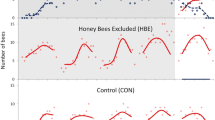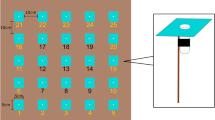Summary
Honeybees often approach flowers of Lotus corniculatus and then fly away without attempting to extract nectar. These rejected flowers contained 41% less nectar than my random sample. The accepted flowers contained 24% more nectar than my random sample. The differences among these three flower-groups were due to differences in the percent of empty flowers in each group rather than the differences in the absolute amount of nectar. Honeybees increased their foraging efficiency by accepting less empty flowers and rejecting more empty flowers than would be expected if they foraged randomly. There are two possible mechanisms for this discrimination-behavior: either the bees are smelling nectar odor or they are smelling bee scent left by previous visitors to the flower. My results are inconsistent with the hypothesis that bees are basing their decision on nectar smell and suggest that they are using bee scent as a means of identifying empty flowers.
Similar content being viewed by others
References
Bell G, Lefebvre L, Giraldeau L-A, Weary D (1984) Partial preference of insects for the male flowers of an annual herb. Oecologia (Berlin) 64:287–294
Butler CG (1969) Nest-entrance marking with pheromones by the honeybee Apis mellifera L., and by a wasp, Vespula vulgaris L. Anim Behav 17:142–147
Cameron SA (1981) Chemical signals in bumble bee foraging. Behav Ecol Sociobiol 9:257–260
Casper BB, La Pine TR (1984) Changes in corolla color and other floral characteristics in Cryptantha humilis (Boraginaceae): Cues to discourage pollinators? Evolution 38:128–141
Cederberg B (1977) Evidence for trail marking in Bombus terrestris workers (Hymnenoptera, Apidae). Zoon 5:143–146
Frankie GW, Vinson SB (1977) Scent marking of passion flowers in Texas by females of Xylocopa virginica texana (Hymenoptera: Anthophoridae). J Kans Entomol Soc 50:613–625
Gori DF (1983) Post-pollination phenomena and adaptive floral changes. In: Jones CE, Little RJ (eds) Handbook of experimental pollination biology. Van Nostrand-Reinhold, New York, pp 31–49
Heinrich B (1979) Resource heterogeneity and patterns of movement in foraging bumblebees. Oecologia (Berlin) 40:235–246
Marden JH (1984) Remote perception of floral nectar by bumblebees. Oecologia (Berlin) 64:232–240
Morse RA (1958) The pollination of birdsfoot trefoil (Lotus corniculatus L.) in New York State. In: Arnold JW (ed) Proceedings of the 10th International Congress of Entomology, Montreal, Canada, 4:951–953
Ribbands CR (1955) Scent perception of the honey bee. Proc R Soc Lond (Biol) 143:367–379
Stephenson AG (1984) The regulation of maternal investment in an indeterminate flowering plant (Lotus corniculatus). Ecology 65:113–121
Waddington KD (1980) Flight patterns of foraging bees relative to density of artificial flowers and distribution of nectar. Oecologia (Berlin) 44:199–204
Zimmerman M (1982) Optimal foraging: Random movement by pollen collecting bumblebees. Oecologia (Berlin) 53:394–398
Author information
Authors and Affiliations
Rights and permissions
About this article
Cite this article
Wetherwax, P.B. Why do honeybees reject certain flowers?. Oecologia 69, 567–570 (1986). https://doi.org/10.1007/BF00410364
Received:
Issue Date:
DOI: https://doi.org/10.1007/BF00410364




